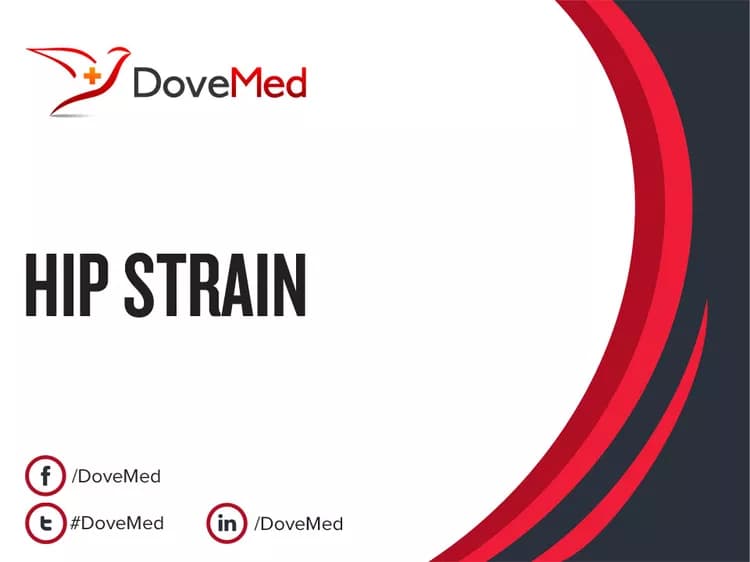What are the other Names for this Condition? (Also known as/Synonyms)
- Hip Strain Injury
What is Hip Strain? (Definition/Background Information)
- Hip Strains are injuries characterized by partial tearing, or abnormal, sudden stretching of one or more muscle fibers within the hip
- A high percentage of muscle strains are the result of an accident or a significant traumatic impact, resulting in immediate severe pain
- Untreated injuries may cause complications, such as osteoarthritis of the hip and chronic pain around the hip. With appropriate treatment that usually does not involve surgery, the prognosis for Hip Strain is generally excellent
Depending on the severity of the injury, physicians usually classify Hip Strains into 3 different grades. These grades include:
- Grade I Hip Strain: Grade I occurs, when only a small number of muscle fibers have been stretched or torn
- Grade II Hip Strain: Grade II occurs, when a larger number of muscle fibers have been stretched or torn, resulting in immediate pain, decreased strength, with occasional bruising
- Grade III Hip Strain: Grade III is characterized by a complete rupture of the muscle fibers within the thigh
Who gets Hip Strain? (Age and Sex Distribution)
- Individuals of any age, gender, race or ethnic group, may experience a Hip Strain
- However, this injury is predominately seen to occur in athletes, or middle-aged to elderly adults
What are the Risk Factors for Hip Strain? (Predisposing Factors)
Common risk factors associated with a Hip Strain include:
- Athletics: Individuals, who participate in a rough or high-impact sports, such as football or basketball, have an increased risk of the injury
- Prior hip injury: Individuals, who have a history of Hip Strain, are at an increased risk for recurrence of the injury
It is important to note that having a risk factor does not mean that one will get the condition. A risk factor increases ones chances of getting a condition compared to an individual without the risk factors. Some risk factors are more important than others.
Also, not having a risk factor does not mean that an individual will not get the condition. It is always important to discuss the effect of risk factors with your healthcare provider.
What are the Causes of Hip Strain? (Etiology)
Causal factors of a Hip Strain include:
- Sports-related injury: Participating in rough or high-impact sports, such as football or basketball
- Falls: A direct fall onto the hip is one of the main causes of a Hip Strain
- Direct trauma: Any significant traumatic event, such as an automobile, motorcycle, or bicycle accident
What are the Signs and Symptoms of Hip Strain?
The pain one experiences with a thigh/hip muscle strain varies; it depends on the severity of the injury. Common signs and symptoms of a Hip Strain include:
- Severe pain within the muscle
- Affected leg appears shorter than the opposite leg, due to abnormal contraction of the damaged muscle
- Deformity of the hip joint
- Inflammation, tenderness, swelling of the hip muscle
- Muscle stiffness, muscular spasms
- Noticeable bruising, redness
- Decreased range of motion of the thigh and hip
- Difficulty walking, sitting
How is Hip Strain Diagnosed?
Physicians may use the following tools to diagnose Hip Strains:
- Physical examination and medical history: Hip Strains can usually be diagnosed by a thorough physical examination
- X-ray: X-rays determine the extent of the injury and if, there are any noticeable stress fractures in the hip
- MRI of hip joint will also help determine the extent of the damage
Many clinical conditions may have similar signs and symptoms. Your healthcare provider may perform additional tests to rule out other clinical conditions to arrive at a definitive diagnosis.
What are the possible Complications of Hip Strain?
Complications of a Hip Strain may include:
- Chronic pain: Abnormal stretching or tearing of the muscle fibers within the hip may result in prolonged and chronic pain
- Osteoarthritis: A Hip Strain increases the risk of developing arthritis within the hip joint
- Hip fracture: Abnormal bruising and swelling may indicate that a hip fracture has occurred
How is Hip Strain Treated?
Mostly non-surgical, conservative treatment methods are provided for Hip Strains. These include:
- Rest: Any activity that aggravates the hip condition should be avoided. The physician usually advice individuals to refrain from certain physical activities, until the symptoms stop
- Ice: Applying ice to the hip should help decrease pain and reduce swelling
- Heat: Applying a damp heated towel to the affected area may help relieve some pain
- Splint or brace: A physician may prescribe a padded brace to restrict hip movement
- Non-steroidal anti-inflammatory medication: Medications, such as ibuprofen and naproxen, can help decrease hip pain
- Physical therapy: After the signs and symptoms have abated, it is important to begin some light motion exercises. Physical therapy may help restore strength, as well as flexibility in the muscles
- Compression: Compression shorts, or an ace baggage wrapped around the affected area is an early treatment technique
- Elevation: Elevation of the leg helps reduce blood from gathering within the injured area
A majority of Hip Strain Injuries do not require surgical interventions. However, a Grade III Hip Strain may require surgical treatment.
How can Hip Strain be Prevented?
A few recommendations to help prevent Hip Strains include:
- Warm up: Warming-up prior to playing a sport is always important. Warm-ups help the muscle stretch better and help decrease the chances of a strain
- Extended stretching: Correct stretching techniques are recommended, before and after any athletic sports event
- Use protective gear: Individuals, who participate in any high-risk sports, such as basketball, should wear appropriate safety equipment to help prevent the possibility of hip injuries
What is the Prognosis of Hip Strain? (Outcomes/Resolutions)
- Most Hip Strains have excellent prognoses without the development of any serious complications; no surgical procedures are also necessary
- A mild to moderate Hip Strain Injury usually heal within 6 weeks; although, a severe injury/strain may require at least 6 months, in order to achieve optimal results
Additional and Relevant Useful Information for Hip Strain:
The following DoveMed website link is a useful resource for additional information:
Related Articles
Test Your Knowledge
Asked by users
Related Centers
Related Specialties
Related Physicians
Related Procedures
Related Resources
Join DoveHubs
and connect with fellow professionals


0 Comments
Please log in to post a comment.